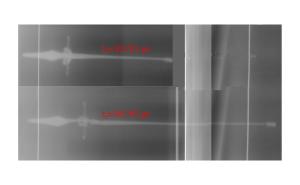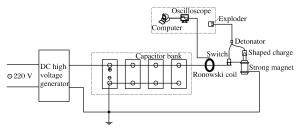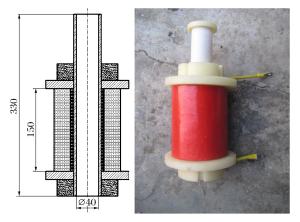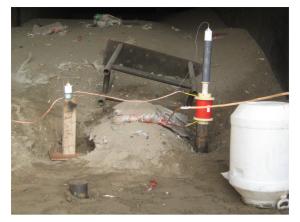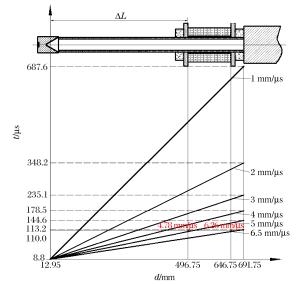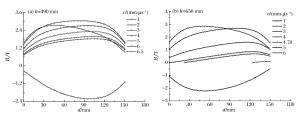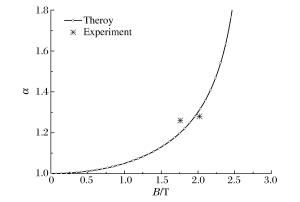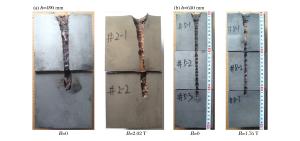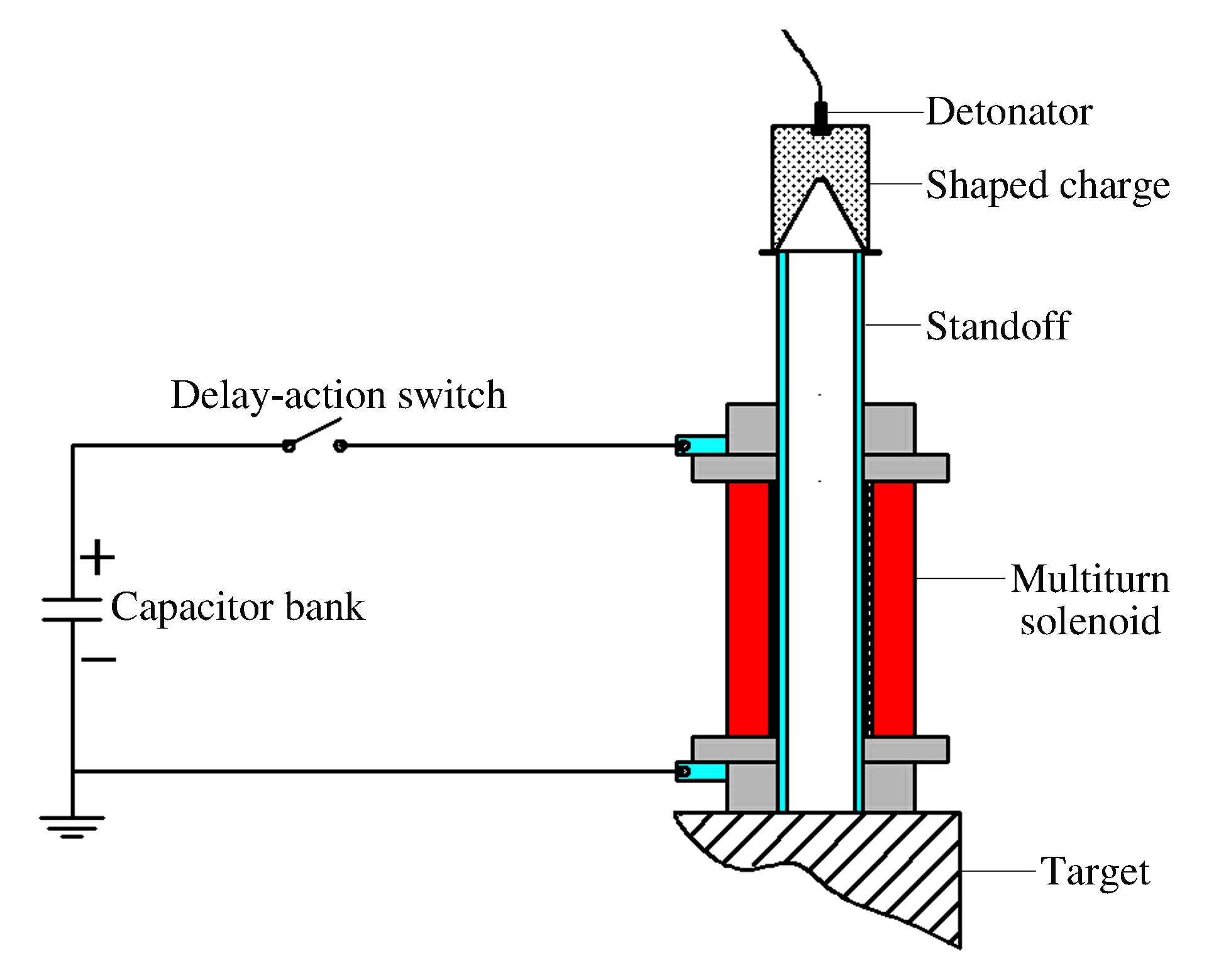Influence of longitudinal magnetic field on coefficient ofultimate elongation of shaped charge jet
-
摘要: 在分析纵向磁场能够增强聚能射流稳定性的基础上,根据聚能射流的运动方程以及聚能射流的塑性失稳条件,推导得到了聚能射流在纵向磁场中的极限拉伸系数计算公式,并计算了有、无磁场情况下极限拉伸系数的比值。通过两种炸高下的实验研究对理论模型进行了验证。结果表明:由于磁场的存在而引起的电磁力抑制了聚能射流颈缩的发展,进而延长了射流成型的惯性拉伸阶段,最终使聚能射流在磁场中的极限拉伸系数在一定程度上得到了增加;理论和实验所得结果吻合较好。运用所建立模型可以较准确地反映磁场对聚能射流极限拉伸系数的影响。Abstract: The coefficient of the ultimate elongation is one of significant parameters related with theoretical calculations of a shaped charge jet (SCJ). Based on the effect of a longitudinal magnetic field on the stress-strain of SCJ, and following the motion equation and the plastic instability condition, the formula of the coefficient of the ultimate elongation of a shaped charge inside the magnetic field was obtained and, using this formula, the ratio of the coefficient of the ultimate elongation was calculated respectively with and without the existence of a magnetic field. In addition, the theoretical model was verified through the experiments with two different standoffs. The results indicate that the electromagnetic force arising from the deformation of the SCJ due to the magnetic field that has penetrated into its material inhibits the development of the necking, and extends the stretching stage before the SCJ breaks up into particles, thus increasing the coefficient of the ultimate elongation. Predictions from the theoretical calculation are in good agreement with the data obtained from the experiments.
-
表 1 测量参数
Table 1. Measured parameters
单元 结构及连接特征 L/μH R/mΩ C/μF 电容器组 4台并联 - - 77.9 强磁体 矩形(2 mm×4 mm)截面铜导线双层并联 12 6.6 - 连接导线 截面为41.5 mm2的铜排 95 32.8 - 表 2 不同速度的射流单元进入和离开强磁体的相关参数
Table 2. Parameters of jet elements with different velocities entering and leaving high field magnet
h/mm v/(mm·μs-1) t1/μs t2/μs Δt/μs B/T 6.5 38.62 61.69 23.1 1.544 6 42.77 67.77 25.0 1.673 5 53.56 83.56 30.0 1.977 490 4 69.75 107.25 37.5 2.337 3 96.73 146.73 50.0 2.654 2 150.70 225.70 75.0 2.239 1 312.60 462.60 150.0 1.666 6 110.0 114.4 4.4 0.450 5 110.0 135.5 25.5 0.424 4.78 110.0 141.4 31.4 0.520 650 4 129.7 167.2 37.5 1.218 3 170.0 220.0 50.0 2.270 2 250.7 325.7 75.0 2.376 1 492.5 642.5 150.0 1.712 表 3 理论计算与实验对比
Table 3. Comparison of theoretical calculation with experiments
h/mm B/T l/mm αexp αth εα/% 490 0 8.01 1 1 0 490 2.02 10.29 1.28 1.31 2.3 650 0 9.18 1 1 0 650 1.76 11.60 1.26 1.20 4.8 -
[1] Walters W P, Zukas J A. Fundamentals of shaped charges[M]. John Wiley, 1989. [2] Chou P C, Carleone J. The stability of shaped-charge jets[J]. Journal of Applied Physics, 1977, 48(10):4187-4195. doi: 10.1063/1.323456 [3] Babkin A V, Ladov S V, Marinin V M, et al. Regularities of the stretching and plastic failure of metal shaped-charge jets[J]. Journal of Applied Mechanics and Technical Physics, 1999, 40(4):571-580. doi: 10.1007/BF02468430 [4] Fedorov S V, Babkin A V, Ladov S V, et al. Possibilities of controlling the shaped-charge effect by electromagnetic actions[J]. Combustion, Explosion and Shock Waves, 2000, 36(6):792-808. doi: 10.1023/A:1002867025761 [5] Hirsch E. A model explaining the rule for calculating the break-up time of homogeneous ductile metals[J]. Propellants, Explosives, Pyrotechnics, 1981, 6(1):11-14. doi: 10.1002/(ISSN)1521-4087 [6] Hirsch E. A formula for the shaped charge jet breakup-time[J]. Propellants, Explosives, Pyrotechnics, 1979, 4(5):89-94. doi: 10.1002/(ISSN)1521-4087 [7] Chou P C, Flis W J. Recent developments in shaped charge technology[J]. Propellants, Explosives, Pyrotechnics, 1986, 11(4):99-114. doi: 10.1002/(ISSN)1521-4087 [8] Curtis J P. Axisymmetric instability model for shaped charge jets[J]. Journal of Applied Physics, 1987, 61(11):4978-4985. doi: 10.1063/1.338317 [9] Hennequin E. Modelling of the shaped charge jet break-up[J]. Propellants, Explosives, Pyrotechnics, 1996, 21(4):181-185. doi: 10.1002/(ISSN)1521-4087 [10] Romero L A. The instability of rapidly stretching plastic jets[J]. Journal of Applied Physics, 1989, 65(8):3006-3016. doi: 10.1063/1.342718 [11] Babkin A V, Ladov S V, Marinin V M, et al. Characteristics of inertially stretching shaped-charge jets in free flight[J]. Journal of Applied Mechanics and Technical Physics, 1997, 38(2):171-176. doi: 10.1007/BF02467897 [12] Littlefield D L, Powell J D. The effect of electromagnetic fields on the stability of a uniformly elongating plastic jet[J]. Physics of Fluids A: Fluid Dynamics, 1990, 2(2):2240. http://cn.bing.com/academic/profile?id=eb3d9e9f7284e2e08798cb78960bc5ba&encoded=0&v=paper_preview&mkt=zh-cn [13] Fedorov S V, Babkin A V, Ladov S V. Salient features of inertial stretching of a high-gradient conducting rod in a longitudinal low-frequency magnetic field[J]. Journal of Engineering Physics and Thermophysics, 2001, 74(2):364-374. doi: 10.1023/A:1016656522643 [14] Fedorov S V. Magnetic-field amplification in metal shaped-charge jets during their inertial elongation[J]. Combustion, Explosion and Shock Waves, 2005, 41(1):106-113. doi: 10.1007/s10573-005-0012-4 [15] Fedorov S V, Babkin A V, Ladov S V. Influence of the magnetic field produced in the liner of a shaped charge on its penetrability[J]. Combustion, Explosion and Shock Waves, 1999, 35(5):598-599. doi: 10.1007/BF02674508 [16] Tucker T J, Toth R P. EBW1: A computer code for the prediction of the behavior of electrical circuits containing exploding wire elements[R]. Albuquerque, NM, USA: Sandia Labs, 1975. [17] Singh M, Bola M S, Prakash S. Determination of dynamic tensile strength of metals from jet break-up studies[C]//Proceedings of the 19th International Symposium on Ballistics. Interlaken, Switzerland, 2001: 7-11. [18] Allison F E, Bryan G M. Cratering by a train of hypervelocity fragments[C]//Proceedings of 2nd Hypervelocity Impact Effects Symposium. 1957: 81. [19] Walters W P, Summers R L. An analytical model for the particulation of a jet from a shaped charge liner[J]. Propellants, Explosives, Pyrotechnics, 1995, 20(2):58-63. doi: 10.1002/(ISSN)1521-4087 -






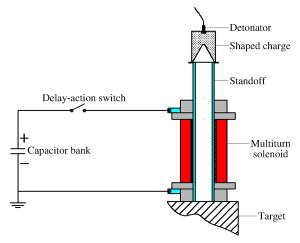
 下载:
下载:

